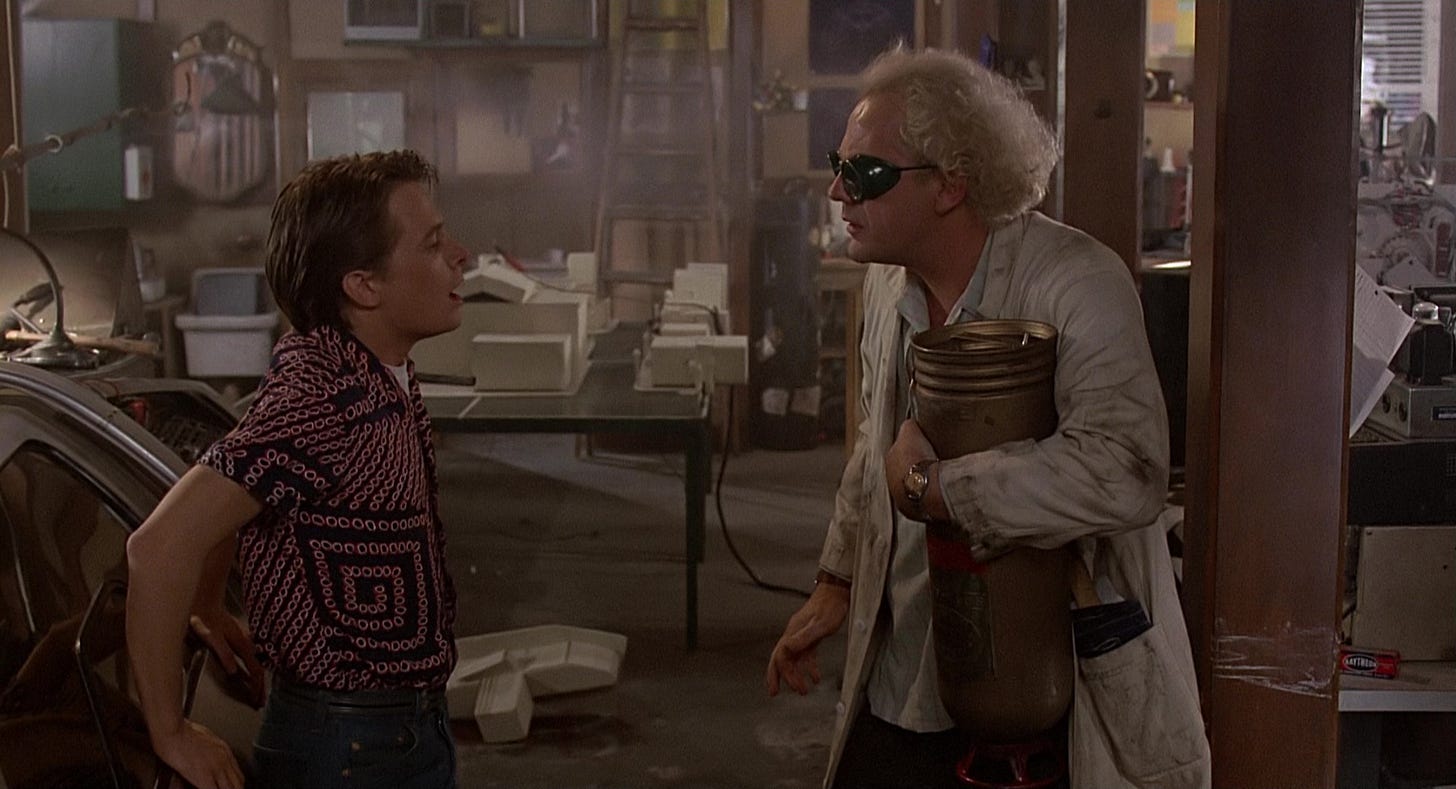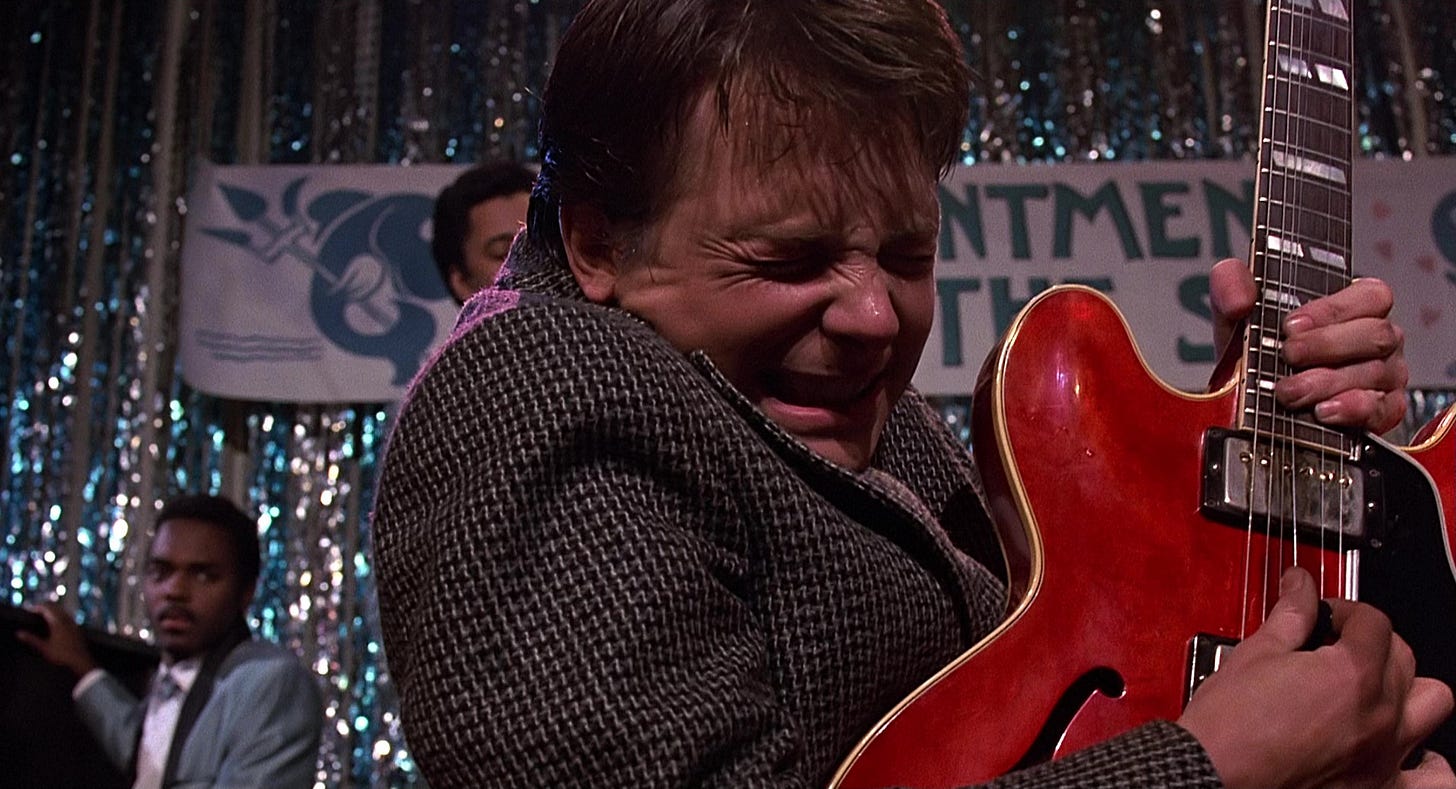Back to the Future
So for the past 5+ years, I’ve been an occasional collaborator with my good friends (and former students) Donavon Thompson and Daniel Wingfield on their fantastic 241 Studios podcast. I’ve proudly and happily been a guest on 29 episodes of the 241 Podcast (most of which I’ve also featured on The Hutch Files). For episode #241 the guys and I decided to breakdown and discuss Back to the Future, directed by Robert Zemeckis and starring Michael J. Fox, Lea Thompson, and Christopher Lloyd. This is an especially portentous episode, because it’s the LAST episode of the 241 Studios podcast. But FEAR NOT, the guys will be back soon with a new name and look, and we’ll continue our discussions and breakdowns as part of their new endeavor. In fact, we’ve already planned our next breakdown.
So check out my analysis below and watch or listen to the podcast. And one final important note: while I really like Back to the Future, I don’t think it’s the best movie ever made, as the graphic below implies! As for Donavon…I’ll let you ask him!
As always, these breakdowns contain SPOILERS, and are only recommended if you've already seen the movie. You can check my introduction to these breakdowns, to get an overview of my process and philosophy.
Feel free to let me know what you think in the comments below!
The Basics
Director: Robert Zemeckis
Writers: Robert Zemeckis and Bob Gale
Release Date: 1985
Runtime: 116 Minutes
IMDB: https://www.imdb.com/title/tt0088763
Movie Level Goals
Protagonist: Marty
External: To get Back to the Future
SUCCESS | FAILURE | MIXED
Internal: None for Marty. However, George must develop the self-belief to kiss Lorraine
SUCCESS | FAILURE | MIXED
Goal Relationship—Internal leads to External: This is an example of the external and internal goals being split among two characters. Here Marty is already a fully realizes character, so he must help his father George have the self confidence to kiss Lorraine. Once Marty helps George succeed at this goal, he is freed to go Back to the Future without his family disappearing.
Three Observations
Observation #1: Marty’s Lack of an Internal Goal
Many people lament that more screenplays aren't written with the care and attention to detail of Back to the Future. And indeed, many contemporary screenplays don't live up to the craft of this now 40 year-old movie. However, one aspect of the screenplay and movie that might suffer compared to contemporary films is Marty's lack of an internal goal. In most Hollywood movies today, protagonists have both an external goal which structures the movie, and an internal goal which provides growth and meaning for both the character and the audience. Marty, on the other hand functions much like a superhero, in that he is fully formed, and shows little growth from the beginning to the end of the movie. This same criticism could be leveled at other movies from the 1980s. In particular, Ferris Bueller's Day Off feels quite similar in having a protagonist that is fully formed and who never changes over the course of the movie. In this way, they feel like Indiana Jones or James Bond; despite being teenagers, they often seem to have all of the answers and the tools they need to succeed at their external goal.
Having said that, I think the situation is a little more complicated. Generally, when we talk about protagonists in Hollywood movies, we say that they either need to change themselves, or change the people and world around them. Neither Marty nor Ferris change themselves. However both protagonists change characters around them, which creates an unusual and compelling structure. In Back to the Future, while Marty provides the structure with his external goal of saving his family and getting back to the future, it is his father George who provides the internal goal. In order for Marty's family to be preserved, George must gather the strength to kiss Lorraine at the dance. Rather than developing this courage on his own, and splitting the protagonist into two characters, it is Marty who helps George develop the self-confidence that he needs to kiss Lorraine. In this way, Marty is still the one who saves his family. Furthermore, although Marty himself doesn't provide the full emotional investment for the audience, his actions in conjunction with his father give us the internal goal and meaning needed to provide a complex structured and meaningful film. Likewise, in Ferris Bueller's Day Off (which I'll be posting about soon) Ferris has a similar relationship to his best friend Cameron.
Despite all of the attention and care that Back to the Future is known for, and the way in which it cleverly develops an internal goal for George, the movie also sets up but fails to deliver a potential internal goal for Marty. After he auditions for the school dance with his band and is rejected, his girlfriend Jennifer encourages him to send his audition tape to the record company. However, echoing words that we'll also hear from his father, Marty it's hesitant because he is worried the record company will reject his tape. This is an interesting moment as it tries to show that Marty has inherited the same lack of confidence that his father suffers from in this timeline. It also sets up the possibility of having Marty need to develop self-confidence in order to succeed at his external goal. However, this lack of self-confidence as a character trait is largely dropped and never seen again over the course of the rest of the movie. Especially when he travels to the past, Marty is supremely confident, constantly getting one over on Biff and encouraging George to have the self-confidence to stand up to bullying, to ask Lorraine to the dance, and of course to kiss her.
Observation #2: The Two Goal Setup at the End of Act 2
Although a lot of Back to the Future is praised for is it clever tying together of ideas, and set ups and payoffs, it's efficient storytelling and structure are also praise worthy. In particular the end of act two offers an interesting set up for the second half of the movie. As Marty and Doc try to figure out how to send Marty back to the future, they develop the plan of harnessing the bolt of lightning that will hit the clock tower on the night of the dance. At the same time, Marty looks at a photo of his family and sees that they are beginning to disappear. This sets up two problems that need to be solved for Marty to return home. First, he needs to make sure that George kisses Lorraine at the dance so that his parents end up together. Second, he and Doc need to make sure that the plan at the clock tower works perfectly, so that Marty's time machine has the power to travel back to the future. This double set up at the end of act two, forecast the structure for the rest of the movie. Act three primarily focuses on Marty's goal of making sure that George and Lorraine end up together, though during this act, we also see Doc in one or two scenes preparing for the lightning strike at the Clocktower. Once Marty succeeds with his act three goal, we already know what the goal for Act four will be: get to the clock tower and get back to the future. This clever bit of storytelling at the end of act two provides the perfect roadmap for the audience to understand where the rest of the movie will go. It also cleverly sets up a dual ticking clock deadline (no pun intended). First, as act three progresses, Marty constantly looks at the photo and sees more and more of his family disappearing. He knows that he must succeed, before his family disappears from the photo entirely. Secondly, we know the exact moment when the lightning will strike the clock tower and both Marty and the audience know that he needs to get into the car and time his drive perfectly to the lightning strike.
Observation #3: Johnny B. Goode
This final observation is a minor one, but I think also serves as an excellent lesson in not being a slave to plotting. The typical Hollywood arch plot is built around a tight cause and effect chain. Goals lead to actions, actions lead to conflict, and conflicts lead to reactions. Each scene is generally set up by the previous scene, and the cause and effect chain keeps the movie moving forward at a tight, quick pace. Overall, Back to the Future is very good at working in this fashion. However, one major exception is when Marty decides to play Johnny B. Goode. After Marvin Barry injures his hand, Marty's only hope of getting his father and mother together is to step in and play guitar. He does this, and of course George and Lorraine dance and despite the minor conflict of someone cutting in, George succeeds and finally kisses Lorraine. This is the climax of act three, and should lead to Marty immediately leaving the dance and heading to the clocktower. In fact, Marty unslings his guitar and seems ready to leave. However Marvin, impressed by Marty's playing, invites him to play another song. Marty initially refuses but with a little more encouragement from Marvin, agrees to play one more song. This happens just after the 87 minute mark, and the movie spends roughly 4-minutes on Marty playing Johnny B. Goode, which initially impresses the kids from the 50s before eventually leaving them bewildered as Marty transitions into an increasingly hard rock style of playing. Finally, Marty wraps things up, says goodbye to his parents, and heads to the clock tower. The scene nicely parallels Marty's desire to play at the school dance in the present, and by being able to play here he does fulfill that dream, which is exactly the type of set up and pay off the movie is known for. But other than allowing Marty to say goodbye to George and Lorraine, this 4-minute scene does not actually advance the plot in any way shape or form. A producer or director focused exclusively on advancing the plot would have immediately advocated cutting this scene. Of course, it's one of the most famous scenes in the movie, and perhaps one of the most famous scenes from a Hollywood film of the 1980s. All of this goes to show that even in a tightly constructed Hollywood movie, there still has to be room for play and moments that please the audience, even if they don't advance the plot.







